Camera traps have been a key part of the conservation toolkit for decades. Remotely triggered video or still cameras allow researchers and managers to monitor cryptic species, survey populations, and support enforcement responses by documenting illegal activities. Increasingly, machine learning is being implemented to automate the processing of data generated by camera traps.
A recent study published showed that, despite being well-established and widely used tools in conservation, progress in the development of camera traps has plateaued since the emergence of the modern model in the mid-2000s, leaving users struggling with many of the same issues they faced a decade ago. That manufacturer ratings have not improved over time, despite technological advancements, demonstrates the need for a new generation of innovative conservation camera traps. Join this group and explore existing efforts, established needs, and what next-generation camera traps might look like - including the integration of AI for data processing through initiatives like Wildlife Insights and Wild Me.
Group Highlights:
Our past Tech Tutors seasons featured multiple episodes for experienced and new camera trappers. How Do I Repair My Camera Traps? featured WILDLABS members Laure Joanny, Alistair Stewart, and Rob Appleby and featured many troubleshooting and DIY resources for common issues.
For camera trap users looking to incorporate machine learning into the data analysis process, Sara Beery's How do I get started using machine learning for my camera traps? is an incredible resource discussing the user-friendly tool MegaDetector.
And for those who are new to camera trapping, Marcella Kelly's How do I choose the right camera trap(s) based on interests, goals, and species? will help you make important decisions based on factors like species, environment, power, durability, and more.
Finally, for an in-depth conversation on camera trap hardware and software, check out the Camera Traps Virtual Meetup featuring Sara Beery, Roland Kays, and Sam Seccombe.
And while you're here, be sure to stop by the camera trap community's collaborative troubleshooting data bank, where we're compiling common problems with the goal of creating a consistent place to exchange tips and tricks!
Header photo: Stephanie O'Donnell
No showcases have been added to this group yet.
Building Animal Detect: Software tool to process wildlife data in minutes using latest cool tech.





- 0 Resources
- 32 Discussions
- 3 Groups
WILDLABS & Wildlife Conservation Society (WCS)
I'm the Bioacoustics Research Analyst at WILDLABS. I'm a marine biologist with particular interest in the acoustics behavior of cetaceans. I'm also a backend web developer, hoping to use technology to improve wildlife conservation efforts.





- 41 Resources
- 38 Discussions
- 33 Groups
- @HeinrichS
- | he/him
Conservation tech geek, custodian (some say owner) and passionate protector of African wildlife, business systems analyst.





- 0 Resources
- 29 Discussions
- 6 Groups
- @Agripina
- | Miss
Frankfurt Zoological Society
As a wildlife conservationist, I am deeply committed to nature conservation, community empowerment, and wildlife research in Tanzania. I've actively engaged in community-based projects, passionately advocating for integrating local communities into conservation.
- 3 Resources
- 25 Discussions
- 6 Groups
- @carlybatist
- | she/her
ecoacoustics, biodiversity monitoring, nature tech



- 113 Resources
- 361 Discussions
- 19 Groups
I'm a software developer. I have projects in practical object detection and alerting that is well suited for poacher detection and a Raspberry Pi based sound localizing ARU project



- 0 Resources
- 432 Discussions
- 7 Groups
- @Nycticebus_scientia
- | he/they
MammalWeb.org
Co-founded citizen science camera-trapping project with interest in developing 100% open source wildlife tech. Advocate for open science/open research. Former Community Councilor of the Gathering for Open Science Hardware.



- 4 Resources
- 25 Discussions
- 3 Groups
- @alexreyyap
- | Male
I am embedded AI systems developer based in Davao City, Philippines.
- 0 Resources
- 0 Discussions
- 5 Groups
- @TaliaSpeaker
- | She/her
WILDLABS & World Wide Fund for Nature/ World Wildlife Fund (WWF)
I'm the Executive Manager of WILDLABS at WWF



- 23 Resources
- 64 Discussions
- 31 Groups
- @bluevalhalla
- | he/him
BearID Project & Arm
Developing AI and IoT for wildlife





- 0 Resources
- 55 Discussions
- 8 Groups
- @CourtneyShuert
- | she/her
I am a behavioural ecologist and eco-physiologist interested in individual differences in marine mammals and other predators



- 0 Resources
- 12 Discussions
- 10 Groups
- @HRees
- | Him/His
WILDLABS & Fauna & Flora
WILDLABS - Programme Development Manager, keen interest in bats, hyenas and tech!





- 15 Resources
- 14 Discussions
- 6 Groups
Lisanne Petracca is hiring TWO technicians within the SPEC Lab Ocelot Research Program to start January 17, 2024.
16 November 2023
A secure platform designed for those working to monitor & protect natural resources. Insight facilitates sharing experience, knowledge & tools to increase efficiency & effectiveness in conservation. By...
7 November 2023
Researchers in Nepal are using vertical cameras and AI technology to track and profile individual spotted deer (Axis axis), similar to the methods used for tigers.
30 October 2023
With the rising threats to biodiversity such as wildlife crime, climate change and human-wildlife conflict today, wildlife monitoring technologies have become vital to study movement ecology, behaviour patterns, changes...
25 October 2023
Do you or someone you love study nocturnal animals? Do you want to film behavior in infrared, but NOT spend $1k on a camera (that will die in the field anyways)? Is short battery life a constant battle? Here, this...
20 October 2023
When considering MPA groundfish monitoring methods: the more, the merrier! New paper out in Journal of Applied Ecology compared three MPA monitoring techniques commonly utilised to survey groundfish populations. They...
20 October 2023
Have you ever wanted to continuously film underwater species and their behaviours for up to 2 days at a low cost? Well now you can with this new open-source design guide published in @MethodsEcolEvol! https://...
5 September 2023
An interesting new paper from a camera trap surveying species' responses and resilience to megafires in the western United States. A great example of how conservation tech can help us understand regional climate change...
24 August 2023
WCS is seeking a Conservation Technology Specialist to join their work in the Okapi Wildlife Reserve.
11 August 2023
Please join us in celebrating this year’s top #Tech4Wildlife Photo Challenge Honorees as chosen by our panel of leading conservation organization judges, and enjoy the story contained within these entries about how our...
4 August 2023
Join us as we count down the WILDLABS community's honorees in the first-ever #Tech4Wildlife Community Choice Awards!
3 August 2023
Exciting opportunity for an experienced biodiversity monitoring expert in ZSL's conservation department
18 July 2023
August 2025
event
event
September 2025
event
event
event
July 2025
58 Products
Recently updated products
4 Products
Recently updated products
| Description | Activity | Replies | Groups | Updated |
|---|---|---|---|---|
| Hi Lucie @luciegallegos ,Great to see ecoSecrets and happy to collaborate in any way I can! All EcoAssist's models are open-source, and the inference code too. With regards to... |
+10
|
Software Development, AI for Conservation, Camera Traps | 6 months ago | |
| Another question. Right now pretty much all camera traps trigger on either PIR sensors or small AI models. Small AI models would tend to have a limitation that they would... |
|
AI for Conservation, Camera Traps, Data management and processing tools, Open Source Solutions, Software Development | 6 months ago | |
| Thanks so much!! |
+10
|
Camera Traps, Latin America Community | 6 months ago | |
| Some thoughts as I have experience working with some of the tech mentioned... Corrodible pin@htarold Did a great job explaining how that works. This pin is used in the pop-up... |
+10
|
Camera Traps | 6 months ago | |
| Hi, I'm collecting screenshots (and explanation if needed) of visualisations that you found useful. It could be charts, maps, tables... |
|
Data management and processing tools, Animal Movement, Camera Traps | 6 months ago | |
| I’ll reply with further commercial details direct to you. I think you are not supposed to discuss to that level in these discussions. This is managed product at this stage, not... |
|
Camera Traps | 6 months 1 week ago | |
| Hello, I am new to camera trapping and I have been researching trail cameras for a project to photograph the city. I need a trail cam... |
|
Camera Traps | 6 months 1 week ago | |
| Do the short videos happen mostly at night? If so, this is likely a problem with low batteries. The higher power required to power the IR flash can cause the camera to... |
|
Camera Traps | 6 months 2 weeks ago | |
| Hi, I am using these for my current project: They seem to be of good quality and support offline SD card storage. These run on 5V/1A. You should be able to run them for... |
|
Camera Traps, Animal Movement | 6 months 3 weeks ago | |
| Hi Simon,We (Reneco International Wildlife Consultants) have an ongoing collaboration with a local University (Abu Dhabi, UAE) for developing AI tools (cameratrap/drone... |
|
Acoustics, AI for Conservation, Animal Movement, Camera Traps, Citizen Science, Connectivity, Drones, Early Career, eDNA & Genomics, Marine Conservation, Protected Area Management Tools, Sensors | 6 months 4 weeks ago | |
| @HeinrichS there’s still time for you or anyone else to make a funding submission to the wildlabs 2025 grants ❤️❤️❤️I haven't applied for wildlabs funding, but I would love for... |
|
Human-Wildlife Coexistence, AI for Conservation, Camera Traps, Emerging Tech | 7 months ago | |
| A video speak a thousand words. I thought I’d share some fun observing the local wildlife in the back yard in thermal. |
|
Camera Traps | 7 months ago |
Mini AI Wildlife Monitor
25 June 2025 12:27pm
26 July 2025 7:04am
A side note, For insects you'll need an higher resolution camera. The Mothbox porject uses a 64MP camera
Parts List | Mothbox
Open Source Low Cost DIY Nocturnal Insect Monitoring
14 August 2025 12:55am
Aloha Luke,
This is an amazing tool that you have created. Are your cameras availble for purchase? We use a lot of camera traps in the Hono O Na Pali Natural Area Reserve on Kauai to pasively detect animals. We do not have the staff knowledge and capacity to build our own camera traps like this.
Camera Trapping Software
21 March 2019 8:50am
25 July 2025 10:30am
Well either or really, but in this particular case we have massive datasets that have already been processed so more the data management side of things, but if there was a potential to include software that would be cool - but I find that its not always possible to necessarily combine them both with the ammount of desired flexibility. In terms of the database side, something like the Panthera IDS system would probably be closest to what I'm searching for (although I'm aware this does also have the software side of things)
26 July 2025 8:19pm
@LydiaKatsis The latest version of TRAPPER has an integrated AI module with multiple models available. We are currently collaborating on a project, Trapper Keeper, sponsored by a WILDLABS Award to make TRAPPER even easier to use and deploy.
Some of the OSCF team, which drive TRAPPER development, are also on WILDLABS: @kbubnicki and @icorei
11 August 2025 11:25am
@LydiaKatsis Trapper was designed to process large-scale camera trap projects, and it offers two interfaces for data management: a simple citizen science interface and an expert interface that will likely meet your needs. As the Open Science Conservation Fund is also the initiator of the CamTrap DP standards, it is fully integrated with Trapper. More details can be provided by @kbubnicki .
Here a bit how Trapper infrastructure works:
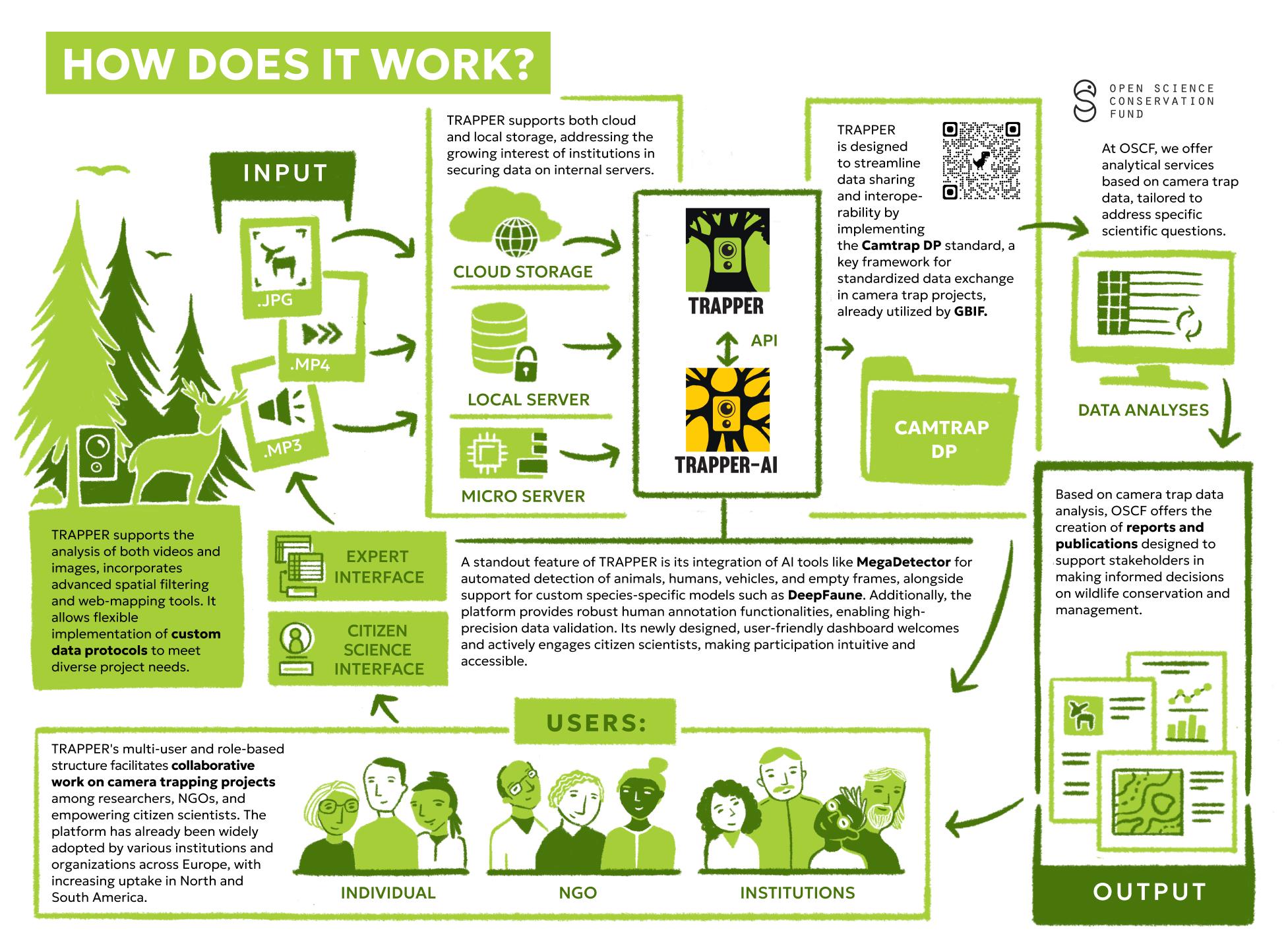
Free online tool to analyze wildlife images
4 August 2025 8:01am
8 August 2025 5:23pm
Hello Eugene, I just tried your service: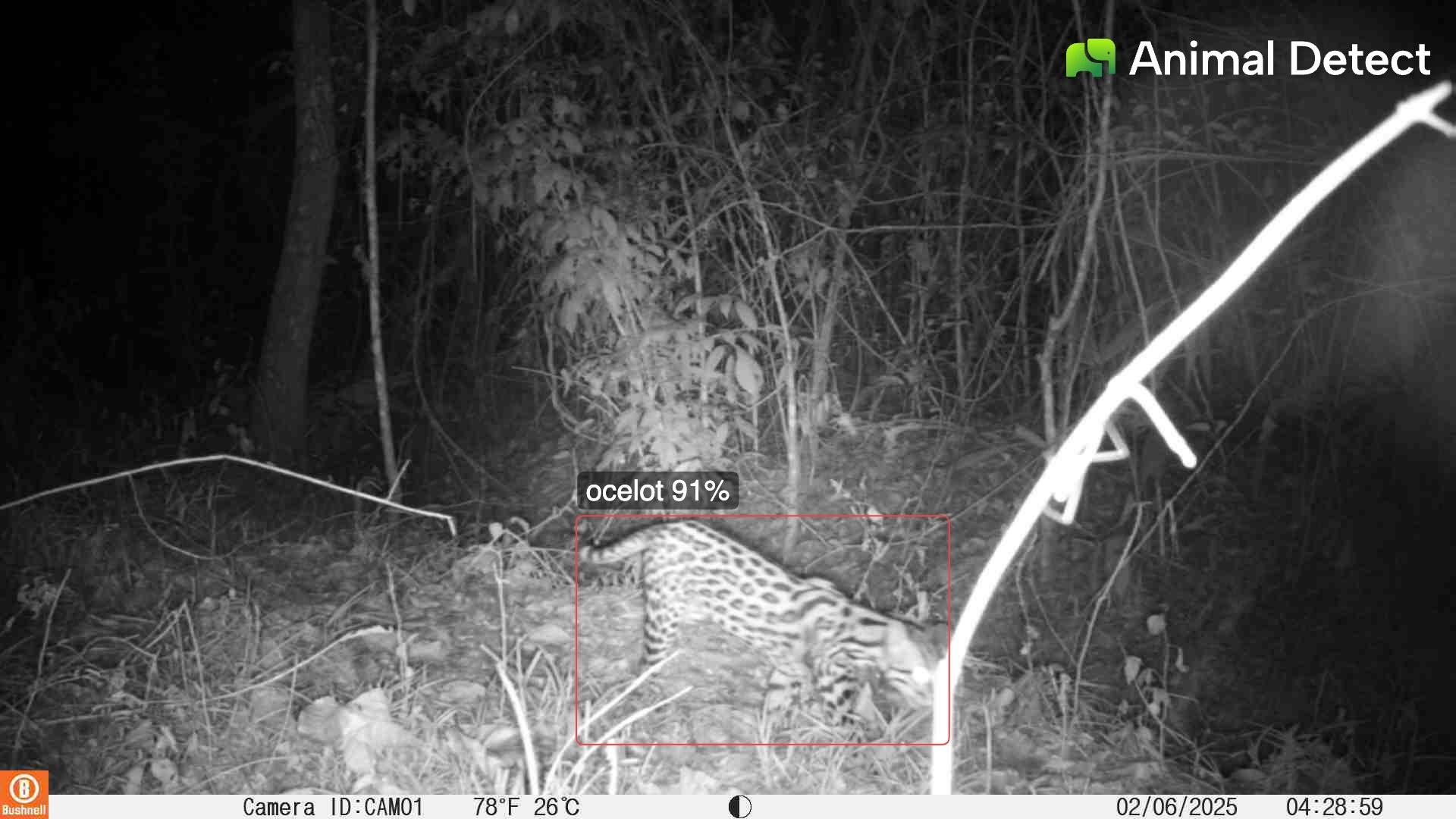
Was wondering how possible will it be to have the option to upload a second image and have a comparison running to let the user know if body patterns are: 'same' or 'different', helping to identify individuals.
Thanks and kind regards from Colombia,
Alejo
Tech4Nature Presents: 2025 Innovation Challenge Workshop Series - Registration Now Open!
6 August 2025 5:09pm
Tech4Nature Presents: 2025 Innovation Challenge Workshop Series - Registration Now Open!
6 August 2025 5:08pm
AI for Conservation Office Hours: 2025 Review
 Jake Burton
and 1 more
Jake Burton
and 1 more
6 August 2025 2:16pm
Collaborate on Conservation Tech Publications With HAAG
5 August 2025 11:46pm
PhD position at Marburg University in Germany
5 August 2025 12:16pm
What metadata is used from trail camera images?
31 July 2025 8:52am
4 August 2025 11:00pm
Hi Hugo, it's great that you are thinking about adding metadata features to Animal Detect! I'll share what I think would be useful from my perspective, but I think there is a lot of variation in how folks handle their image organization.
Time and date are probably the most important features. I rename my image files using the camtrapR package, which uses Exiftool to read file metadata and append date and time to the filename. I find this method to be very robust because of the ability to change datetimes if needed -- for example, if the camera was programmed incorrectly, you can apply a timeshift to ensure they are correct in the filenames. Are you considering adding Exif capability directly to Animal Detect? Otherwise, I think that having a tool to parse filenames would be very helpful, where users could specify which parts of the filename correspond to camera site, date, time, etc., so that this information is included in downstream processing tasks.
I have found it frustrating that information such as camera name and temperature are not included in file metadata by many camera manufacturers. I have used OCR to extract the information in these cases, but it requires a bit of manual review, and I wouldn't say this is a regular part of my workflow.
Camera brand and model can be useful for analysis, and image dimensions and burst sequence can be helpful for computer vision tasks.
Hope this helps!
Cara
5 August 2025 7:43am
Thank you for your reply!
It surely helps, we have use exif for a while to read metadata from images, when there is information available. Could be nice to maybe see if we could “write” some of the data into the metadata of the image, instead of just reading. Really good idea with the filename changes and structure. I will add it to a list of possible improvements and see if/how we could implement it.
Again, thanks for the feedback 😊
2025 Workshop on Camera Traps, AI, and Ecology
4 August 2025 10:47am
Seeking Feedback: Offline-Friendly Conservation Tech Training for African Farmers and Youth
3 August 2025 12:17pm
Jupyter Notebook: Aquatic Computer Vision
25 January 2024 5:50am
27 January 2024 4:07am
This definitely seems like the community to do it. I was looking at the thread about wolf detection and it seems like people here are no strangers to image classification. A little overwhelming to be quite honest 😂
While it would be incredible to have a powerful model that was capable of auto-classifying everything right away and storing all the detected creatures & correlated sensor data straight into a database - I wonder if in remote cases where power (and therefore cpu bandwidth), data storage, and network connectivity is at a premium if it would be more valuable to just be able to highlight moments of interest for lab analysis later? OR if you do you have cellular connection, you could download just those moments of interest and not hours and hours of footage?
27 January 2024 6:11am
Am working on similar AI challenge at the moment. Hoping to translate my workflow to wolves in future if needed.
We all are little overstretched but it there is no pressing deadlines, it should be possible to explore building efficient model for object detection and looking at suitable hardware for running these model on the edge.
28 July 2025 1:20pm
Wow this is amazing! This is how we integrate Biology and Information Technology.
Thermal imaging when it's 36 degrees outside
3 July 2025 4:58pm
4 July 2025 3:07pm
Thanks for sharing, nice to see!
17 July 2025 12:24pm
Which product is it? Thanks
17 July 2025 12:43pm
It's a wildlabs security innovations thermal camera product. We are a new company (The Netherlands), just formed last year. We just have one wildlife customer at the moment in Australia for the thermal modules, from a progressive early adopter :)
Our next work package will be to build a website to show all the products and options, this is sorely needed. In the meantime however, I'm happy to show you it operating over a video meeting if you like, please message me directly if you would like this. At the moment we have a camera that has the following functionality in the most extended version:
* Thermal module, options are 640x512, 384x288, 256x192
* Low light visible light module, currently testing different modules with very low light sensitivity based on star vis 2 chips and large pixel sizes
* Remote access via a VPN with a USB cell modem
* Local large model (25,000,000 parameters AI recognition of some animals
* Motion detection (Works really well with thermal as the images are very stable)
* Video alerting triggers
* 24/7 h264 recording with very high quality audio input, can make this be an audio ARU on the same device is desired, also a sound localizing one.
* Local relay response input/output
* Build in extensive GUI configured state machine
We are working towards and off the shelf self configured version, but in the meantime we are offering customizing and working with the customer.
We can also sell a fairly dumb version which is effectively just a network thermal camera if that's all you need.
There is a link to more videos on the inventory page below
The radiometric version has really impressive onboard image processing. I uploaded a new video that shows this the other day.
The sound recording system we can add is from our open source sbts ARU project (
GitHub - hcfman/sbts-aru: Low cost Raspberry Pi sound localizing portable Autonomous Recording Unit (ARU)
Low cost Raspberry Pi sound localizing portable Autonomous Recording Unit (ARU) - hcfman/sbts-aru
). Which provides sound localization if you want as well. Note, it can record flac files that are localizable as well as merging the broadcast quality sound into both the thermal and visible light h264 quicktime recordings at the same time on the same platform.
Advise needed on Close Focus Camera Traps
27 June 2025 7:30pm
4 July 2025 5:43pm
This is great! Thanks, Akiba!
12 July 2025 12:50pm
I use the lenses from reading glasses (3.0 magnification) as mentioned. I pop the lens out of the frames and then tape it over the camera lens with electrical tape as we use the cameras for other projects and need to remove the reading lens. It does not seem to affect the image quality except in high moisture situations where it sometimes gets fogged but that happens with the regular camera lens sometimes too.
15 July 2025 2:44pm
That's great. Thanks!
Halow wifi, local AI, thermal + visible
6 July 2025 11:15am
12 July 2025 1:08am
Thanks for sharing! I've been thinking about using WiFi links for some applications. Any idea how much power they require?
12 July 2025 6:53pm
Idles around 2W, peaks a bit more than 6W.
Need Assistance regarding selecting a camera
23 December 2022 10:50am
11 February 2023 3:20am
Hi Vishnu,
Considering only motion detection video, it is possible to modify (most) camera traps to trigger an external piece of equipment like an audio recorder. I'm not aware of any suitable off-the-shelf recorder, but I can build you one. However many camera traps that will take video will also record audio, although the quality may not be suitable for all types of audio analysis.
11 July 2025 6:29am
Yes. Thank you. We bought Brinno TLC 300 and we just deployed it.
11 July 2025 10:33am
We have a camera that could do this over some distance away due to a thermal module being involved. It will also record very high quality audio (Nature recording audiophiles rave about the microphone being used). can trigger on motion detection and also in addition to a thermal module has a low light module that can record in colour under moon light. Normally, the system records continuously and triggered for video alerting as it can be accessed remotely.
But it would draw much more power than microcontroller based systems (Around 5W for motion triggering) so you would need to place a solar panel with it and it would be quite a big one. This is offset by the ability to view from much greater distances, audio record, perfect visibility in pitch darkness.
Our next work packages will be to make a website to highlight all that, we don't have that yet. It would cost more than the brino as well, however likely you would need less instances (Maybe one versus many).
Below is a video review of the em272 microphone, which is what we use in our setup for recording the audio. We also merge in this external audio into our continuous video streams.
It could also record 24/7 continuously full motion h264 video with em272 microphone audio without replacing the media if you wish. It would need power for that whole time though.
Please contact me directly if this is relevant to your use case.
CamTrapAI Workshop Series
8 July 2025 3:03pm
What Can Camera Traps Data Tell Us? (Besides the Obvious)
22 May 2025 10:24pm
16 June 2025 2:28pm
A related publication that might be of interest, with the Norwegian Arctic Fox monitoring program we used camera trap time series to study phenological plasticity in arctic fox moulting, specifically the transition from winter to summer coat. We were looking at how this process responds to environmental variation, such as the length of the snow season and temperature fluctuations (e.g., colder years with prolonged snow cover vs. earlier snowmelt and warmer winters). This builds on similar ideas of extracting phenological and climatic insights from camera trap data. :)
Here's a link to the publication "A camera trap-based assessment of climate-driven phenotypic plasticity of seasonal moulting in an endangered carnivore" https://doi.org/10.1002/rse2.304
18 June 2025 12:27pm
Great! thank you @Lucie_LprtDvldr !
7 July 2025 9:46am
Here is a nice review on the use of camera traps in various ecological contexts:
https://onlinelibrary.wiley.com/doi/toc/10.1002/(ISSN)2045-7758.ecological-insights 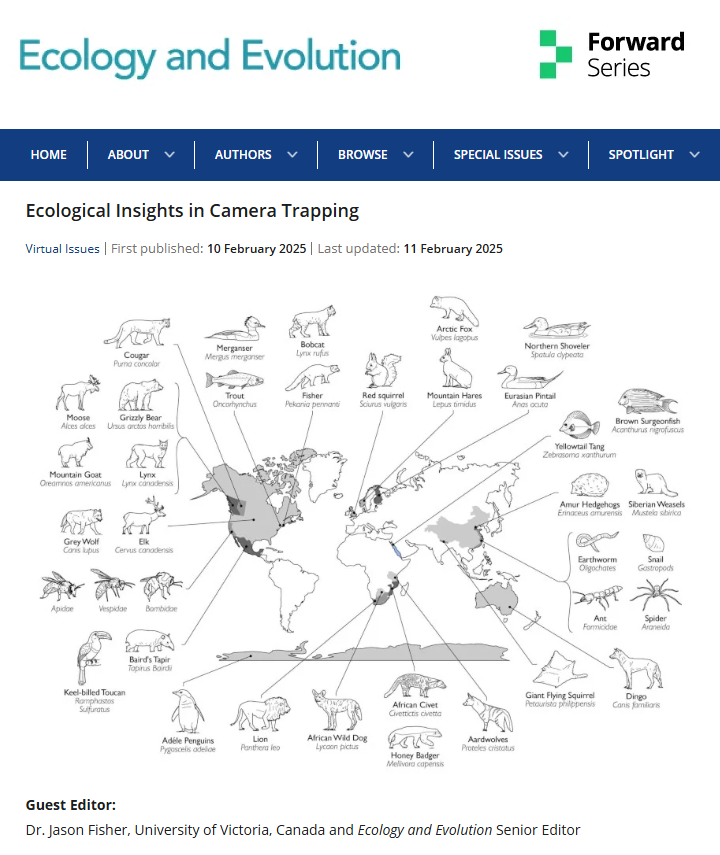
Monitoring Wolf Communication with DIY Camera Setup – Feedback & Advice Welcome!
23 June 2025 1:59pm
30 June 2025 6:51pm
And a system with a 640x512 thermal and visible light camera (Cheap, not sensitive one) looks like this: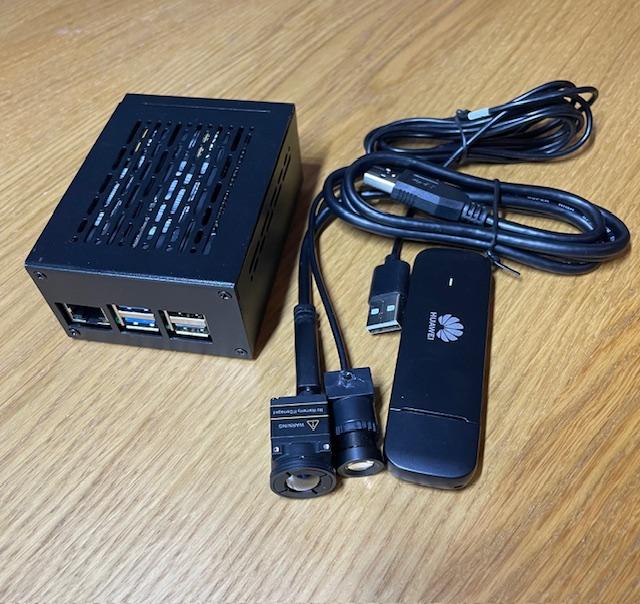
An alternative to getting really close is further away with a long thermal lens. These are more expensive than the lens above and the price goes up the bigger the lens, but it does open up possibilities. Also available for those with big budgets are 1280x1024 resolution thermal modules and zoomable thermal imaging lenses. The zoomable one has a 30-180mm zoomable lens and looks like this: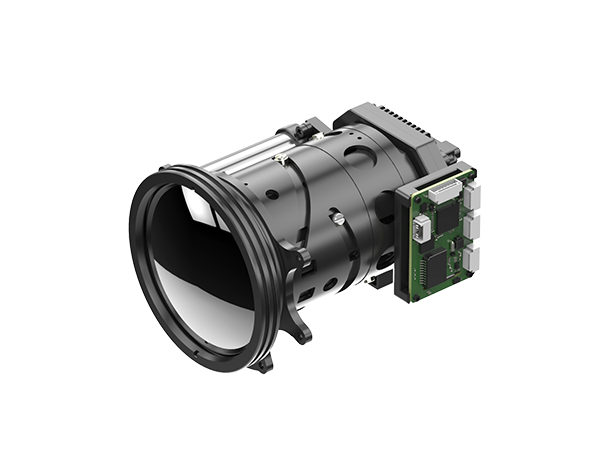
2 July 2025 10:59pm
A few bits of free/cheap improvement on waterproofing which is always a massive pain:
- if you can't seal it entirely then drill a drain hole in the bottom
- Cover every exposed electronic bit you can with a spray-on clear coat. Clear nail varnish for small areas. You can get electric specific products but most spray laquers work.
- Smear dielectric grease on battery and cable connections you can't protect with clear coat.
6 July 2025 2:11am
Super nice project!
How do you imagine thermal cameras will help with vegetation? It cannot exactly look though it.
Rather than placing the camera inside the metalbox have you thought about simply placing it high and out of reach of the wolves?
[Official] Reolink Go Ranger PT - 1st 4K 4G Cellular Trail Camera
The Go Ranger PT offers true 4K image quality and excellent night vision with a large F1.6 aperture and the invisible 940nm no-glow IR LEDs. The battery camera also comes with a solar panel and works over a 4G mobile network, perfect for a wilderness adventure, such as observing wildlife, etc.
Although it sounds like you are happy with locally saved footage, having some live feed is a great insurance that the system is up and running and not in need of service!
A new underwater camera trap for freshwater wildlife monitoring
2 July 2025 7:35am
Applying Open-Source Computer Vision Models to Camera Trap Images
1 July 2025 11:01pm
I WANT TO TELL YOUR STORY
29 June 2025 10:22am
New Group Proposal: Systems Builders & PACIM Designers
18 June 2025 2:52pm
19 June 2025 9:08am
Hi Chad,
Thanks for the text. As I read it, PACIMs play a role in something else/bigger, but it doesn't explain what PACIMs are or what they look like. Now I've re-read your original post, I'm thinking, maybe I do understand, but then I feel the concept is too big ( an entire system can be part of a PACIM ? ) to get going within a WildLabs group. And you want to develop 10 PACIMS within a year through this group? Don't get me wrong, I am all for some systems change, but perhaps you're aiming too high.
19 June 2025 12:19pm
Hello again sir - PACIMs really mean 'projects' is the way I see it. Each part of the acronym can be seen as a project (if you have an assignment to do, you have a project really).
As for your query on 10 projects in 'this' group - I should ask for clarification if you mean particularly acoustics or in any group (I see now this is the acoustics thread after I selected all the groups for this post). If you are asking on acoustics, you're right - I am unsure on 10 as I am not too keen on acoustics yet. If you are asking 10 projects as a whole like 10 projects in the funding and finance group - I believe 10 to be a very reasonable number. Our projects we have co-created are for the most part replicable, rapidly deployable, quickly scalable, fundable through blended finance and more.
Thank you again for the feedback.
19 June 2025 1:43pm
Thank you for your reply, Chad
I meant 10 as a whole, indeed. Perhaps you see your post in one group, but since it is tagged for all groups, I assumed you meant 10 in total.
In your first post you explain PACIM stands for "Projects, Assignments, Campaigns, Initiatives, Movements, and Systems", so I understood it as more than just projects. Obviously, many things can be packed into a project or called a project, but then, what does it mean that 'Projects' is part of the list?
Well, if you think 10 projects is doable, then don't let me stop you.
ICCB 2025 – Let’s Connect!
9 March 2025 5:06am
16 June 2025 8:33am
Hey Stephanie,
I have dropped you couple of links. I believe we also have a booth somewhere.
16 June 2025 8:41am
Hi Stephanie,
It’s great to hear about your exciting work and that you’ll be attending ICCB 2025 — congratulations on presenting!
The Savannah Tracking team is participating at the exhibition, and we’d love for you to stop by our booth 15.
Given your previous interest in collaring domestic dogs and collecting high-resolution GPS data, it might be a great opportunity for us to connect in person and dive deeper into how our lightweight collar solutions — like those currently deployed on Dingoes — could support your project. We'd be happy to show you how our satellite-enabled collars work, demo our data platforms, and explore a potential fit for your needs.
19 June 2025 7:34am
Thanks Fadhilla! I met with your colleague Henrick at the booth. :-)
Prototype for exploring camera trap data
20 January 2025 10:23pm
7 May 2025 10:49am
@Jeremy_ For the Python implementation of basic occupancy models (as suggested by @ollie_wearn ), please refer to these two projects:
I second @martijnB suggestion to use spatially explicit occupancy models (as implemented in R, e.g., https://doserlab.com/files/spoccupancy-web/). However, this would need to be added to both of the aforementioned Python projects.
17 May 2025 10:53am
Lively and informative discussion, I would very much like to contribute if there is some active development work with regards to this.
I have recent experience with using Model Context Protocol (MCP) to integrate various tools & data repositories with LLMs like Claude. I believe this could be a good idea/path whereby we can do the following:
1. use the images & labels along with any meta-data, chunk/index/store it in vector db
2. integrate with existing data sources available by exposing the data through MCP server
3. Use MCP friendly LLM clients (like Claude) to query, visualize and do other open-ended things leveraging the power of LLM and camera trap data from various sources.
Regards,
Ajay
13 June 2025 1:38pm
Hi Jeremy,
I am copying here a reply from Juliane Röder, who is not on the forum here:
The GFBio VAT tool seems to do all the desired analysing and visualising stuff - but it isn't specialized on camera trap data. Instead, it harvests GBIF, GFBio data centers, and environmental data that you can combine in any way you want: https://vat.gfbio.org/#/
Documentation with some example code and notebooks is here: https://docs.vat.gfbio.org
A standalone tool for camarea trap data and images is nice, but maybe joining forces and adding some functionality to the VAT tool to better handle camera trap data would be a more sustainable solution...?
The VAT tool can give you some simple statistics of the chosen data (e.g. occurences of wild cats in central Europe in winters 2000-2015), and some simple analyses (wild cat occurences and snow depth). It's focus is on geospatial analyses of occurrence data. They do not have any functionality specific for camera trap data - yet.
My point was, that if you want geospatial analyses and/or additional data to compare to camera trap data, you probably don't have to build a new tool.
I'm not involved with the development of the VAT tool, but I could help with the contact. I know the VAT team.
You can contact her on juliane.roeder@uni-marburg.de.
I did a quick exploration of the VAT tool. It is built quite differently, and my first impression is that it is less accessible; however, as you become more familiar with it, you discover a wide range of options to explore for DwcA occurrences.
I believe it is extremely valuable to also have a tool that works directly with the richest data (Camtrap DP), rather than relying on translated data (Darwin Core), where important details and data structure are lost.
I also think the goals of both tools are different: map-based analysis vs. exploration.
But still usefull to get to know about each other :-)
Cellular Camera Traps in Europe
6 March 2025 12:17pm
10 March 2025 3:46am
We manufacture the DOC AI Cam. It's a thermal camera, so particularly good for nocturnal animals. It comes with a 4G modem. It might meet your needs?
Any experience using camera traps for wading bird presence?
5 June 2025 8:04pm
WILDLABS AWARDS 2025 - Trapper Keeper - a scalable and energy-efficient open-source camera trap data infrastructure
30 May 2025 12:05pm
2 June 2025 10:24pm
Help needed : Overview of Image Analysis and Visualization from Camera Traps
2 June 2025 1:59pm
2 June 2025 2:17pm
This camera trap survey addresses the crucial need for a unified and comprehensive solution to improve data reliability and standardize monitoring techniques in wildlife research. Well done !
2 June 2025 3:18pm
This survey on camera trap use is a valuable effort to improve data quality and consistency in wildlife monitoring. Looking forward to the results and how they will help shape best practices and future research. Great initiative!
Dual-/Multi-Use Technology Strategies
1 April 2025 11:46pm
15 April 2025 6:17pm
That is a great point and the current international trade climate has been making supply chain even more difficult. This also deeply affects US companies given much of the US goods manufacturing and assembly happening in China. Over the last few years, I have been seeing US hardware companies (e.g. drone platform and component OEMs) sourcing their goods from India, Turkey, Canada, and more recently in African and South American nations. Because of the last 3-to-5 years of increasingly restrictive and costly international hardware trade, there has been a emergence of specialized component manufacturers internationally. For European companies interested in providing hardware services to the US, I would suggest diversifying the supply chain beyond China. Given the current climate and trends, that added supply chain resilience may be a good idea, regardless of work with the US.
15 April 2025 7:36pm
This is more than the supply chain though. The point was the company itself cannot use any tech for anything from the 5x companies. So in my case my ISP is incompatible. Essentially I see the only companies making that kind of sacrifice are ones that want to devote themselves to defence only.
Of course. That’s US defense as a customer. European defence is fully on the table.
It’s just sad that it’s not restricted to defence. US government wildlife organisations cannot buy European tech unless that European company was pure in their eyes.
15 April 2025 8:37pm
True, the US ecosystem is a challenging space right now, for basically all sectors.
We should not let the US chaos prevent us from engaging with opportunities in other nations' multi-use markets. A company's ability and journey to tap into other markets is very unique to them (product, team, finances, infrastructure, agility), and some simply cannot adapt. There is no one size fits all (or even most) solution when it comes to multi-use strategies. It is important that we are systematic about evaluating the cost to adapt our product-service to a different market, and the value of new opportunities in that new market, without losing track of underlying conservation and social good needs.







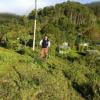


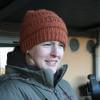
























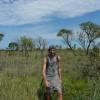





































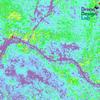





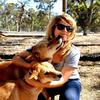









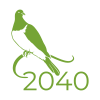



18 July 2025 9:29am
Hi Ross,
Nice project, thanks for sharing!
How does it perform in the field? Have you tested out power usage and battery life etc?
Happy to help where I can with the IMX500, I've got a discord Server linked on my youtube channel.